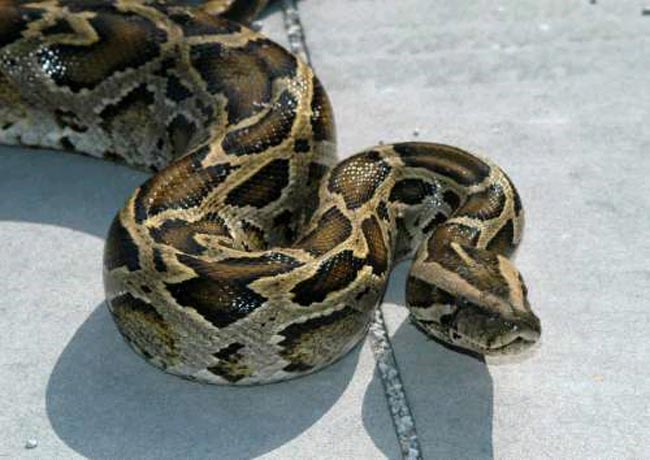Giant Invasive Snakes Threaten U.S. Ecosystems

In a new report, the U.S. Geological Survey (USGS) assessed the ecological risks that nine giant non-native snake species would bring if they were ever established in the United States. The result: Five of them pose a high risk and four pose a medium risk.
The nine species, including non-native boa, anaconda and python species, are invasive or potentially invasive in the United States. However, the authors write in their report that "at present, the only probable pathway by which these species would become established in the United States is the pet trade."
Among the high risk species are Burmese pythons, northern and southern African pythons, boa constrictors and yellow anacondas. These species put larger portions of the U.S. mainland at risk, constitute a greater ecological threat, or are more common in trade and commerce. Medium-risk species, including the reticulated python, Deschauensee’s anaconda, green anaconda and Beni anaconda, constitute lesser threats in these areas, but still are potentially serious threats.
Both Burmese pythons and boa constrictors have been documented as reproducing in the wild in South Florida, with population estimates for Burmese pythons in the tens of thousands, although there has been some debate about whether or not the pythons will migrate out of this habitat.
The high risk snakes "mature early, produce large numbers of offspring, travel long distances, and have broad diets that allow them to eat most native birds and mammals,” which increases their risk to ecosystems, the authors wrote.
In addition most of these snakes can inhabit a variety of habitats and are quite tolerant of urban or suburban areas, they said. Boa constrictors and northern African pythons, for example, already live wild in the Miami metropolitan area.
The authors also note that native U.S. birds, mammals, and reptiles in areas of potential invasion have never had to deal with huge predatory snakes before — individuals of the largest three species reach lengths of more than 20 feet and upwards of 200 pounds.
Sign up for the Live Science daily newsletter now
Get the world’s most fascinating discoveries delivered straight to your inbox.
USGS researchers used available science data to forecast areas of the country most at risk of invasion by these giant snakes. Based on climate alone, many of the species would be limited to the warmest areas of the United States, including parts of Florida, extreme south Texas, Hawaii, and America’s tropical islands, such as Puerto Rico, Guam, and other Pacific islands. For a few species, however, larger areas of the continental United States appear to exhibit suitable climatic conditions. For example, much of the southern U.S. climatic conditions are similar to those experienced by the Burmese python in its native range. However, many factors other than climate alone can influence whether a species can establish a population in a particular location, the report says.
Individuals of some species may also pose a small risk to people, although most snakes would not be large enough to consider a person as suitable prey. Mature individuals of the largest species — Burmese, reticulated, and northern and southern African pythons —have been documented as attacking and killing people in the wild in their native range, though such unprovoked attacks appear to be quite rare. The snake most associated with unprovoked human fatalities in the wild is the reticulated python. The situation with human risk is similar to that experienced with alligators: attacks in the wild are improbable but possible.
The report also notes that there are no control tools yet that seem adequate for eradicating an established population of giant snakes once they have spread over a large area. Making the task of eradication more difficult is that in the wild these snakes are extremely hard to find since their camouflaged coloration enables them to blend in well with their surroundings.
“This report clearly reveals that these giant snakes threaten to destabilize some of our most precious ecosystems and parks, primarily through predation on vulnerable native species,” Dr. Robert Reed, a coauthor of the report and a USGS invasive species scientist, said in a statement.
The Fish and Wildlife Service and the National Park Service will use the 300-page report to assist in further development of management actions concerning the snakes when and where these species appear in the wild. In addition, the risk assessment will provide current, science-based information for management authorities to evaluate prospective regulations that might prevent further colonization of the U.S. by these snakes.
- Image Gallery: Snakes of the World
- Will Deadly Pythons Spread Beyond Florida?
- All About Snakes










